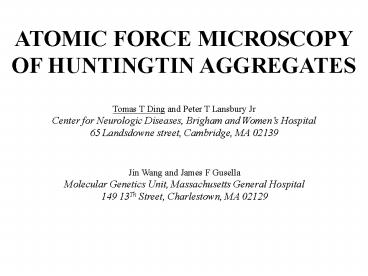ATOMIC FORCE MICROSCOPY - PowerPoint PPT Presentation
1 / 9
Title:
ATOMIC FORCE MICROSCOPY
Description:
Center for Neurologic Diseases, Brigham and Women's Hospital. 65 Landsdowne street, Cambridge, MA 02139. Jin Wang and James F Gusella ... – PowerPoint PPT presentation
Number of Views:259
Avg rating:3.0/5.0
Title: ATOMIC FORCE MICROSCOPY
1
ATOMIC FORCE MICROSCOPY OF HUNTINGTIN AGGREGATES
Tomas T Ding and Peter T Lansbury Jr Center for
Neurologic Diseases, Brigham and Womens
Hospital 65 Landsdowne street, Cambridge, MA 02139
Jin Wang and James F Gusella Molecular Genetics
Unit, Massachusetts General Hospital 149 13Th
Street, Charlestown, MA 02129
2
ABSTRACT
- Background The extent of in vitro formation of
aggregate with amyloid characteristics by the N-
terminus of huntingtin with glutamine repeat
lengths in the pathological range correlates
inversely with the age of onset of Huntingtons
disease. Furthermore, amyloid has been detected
in HD-brain inclusions . Finally, huntingtin
aggregation, like aggregation of other
amyloidogenic and disease-related proteins such
as amyloid-b peptide and a-synuclein, may follow
a nucleation-dependent polymerization pathway .
Because both amyloid-b peptide and a-synuclein
form pre-fibrillar and possibly neurotoxic
aggregates in vitro we speculate that mutant
huntingtin assembles into protofibrils and that
those could play a role in the onset of
Huntingtons disease. - Methods We utilize atomic force microscopy (AFM)
to image huntingtin aggregates adsorbed to mica.
In AFM a substrate is scanned with a sharp tip
attached to a cantilever while the deflections of
the cantilever are translated into a relief-map
of the surface. Such maps provide us with
3-dimensional morphological information about
single proteins and protein aggregates. - Results and conclusions Huntingtin fibrils
feature a diameter of 7-10 nm, similar to the
fibrils described in the context of Alzheimers
and Parkinsons disease, regardless of glutamine
repeat length. Preliminary data implies that a
higher number of fibrils (eg per unit volume) is
formed whereas the lengths of the fibrils remain
relatively constant on increasing glutamine
repeat number suggesting that the nucleation
rate increases with increased glutamine repeat
length. We also have indications that aggregating
huntingtin forms pre-fibrillar aggregates in
vitro. Thus, within 2h Q41 huntingtin produces
spherical assemblies with an average height of
2.4 nm, similar to the spheres detected in
aggregating a-synuclein . Apparently, this
distribution is not stable but changes over time,
so after 98h the average height increased to 3.4
nm as the measured particle density dropped from
400 to 20 particles per square micron. Since
huntingtin Q41 is capable of forming both fibrils
and a protofibril-like intermediate in vitro we
argue that other huntingtin mutants also form
such intermediates, and that they could be
considered as possible drug targets.
3
Atomic force microscopy (AFM)
Examples
Carbon atoms
Creates a relief map of the surface. Higher
features are represented with brighter colors.
b-Amyloid fibril
4
Red cursors (horizontal)131 nm Green cursors
(height) 8.1 nm
b-Amyloid fibril
Individual Particles
Cross-section
Histogram
Populations
Mutant (A53T) a-Synuclein (protofibrils)
5
Q41 2h
Q41 98h
Huntingtin exon 1 incubated at 37. The
particles were counted and heights measured.
n 2342, coverage 33 particle height 53 nm
n2526, coverage 8.6 particle height 32 nm
6
Preliminary conclusion Particle-size
distribution changes over time
2h
Q41
98h
Height distribution histograms taken at 2h and
98h. Note that this is relative amounts the
total particle number is the same for the two
distributions.
7
Annular Q41 protofibrils?
Cursors 18 nm. Height 2.5 nm. Mean width 25
nm. Volume (10-18 cm3). Calculated
weight corresponds to 56 Q41 monomers.
8
For comparison a-Synuclein Protofibrils.
Spherical (left) and Annular protofibrils
formed by the a-synuclein A53T Mutant. This
protein is Associated with familial Parkinsons
disease. The A30P mutant and wild
type a-synuclein also form annular
structures. Annular A53T (from AFM) Diameter
10-12 nm Height 1.9-2.3 nm.
100nm square
2.5m square
Height 31nm N 2993
EM by Hilal A. Lashuel, Harvard Medical
School. Scale bar 100 nm.
9
Summary
Aggregating huntingtin rapidly forms spherical
aggregates with a size distribution that changes
over time. Preliminary data suggest that Q41
is Capable of forming annular toxin-like
Structures similar to those formed by
a-synuclein (and b-amyloid).































